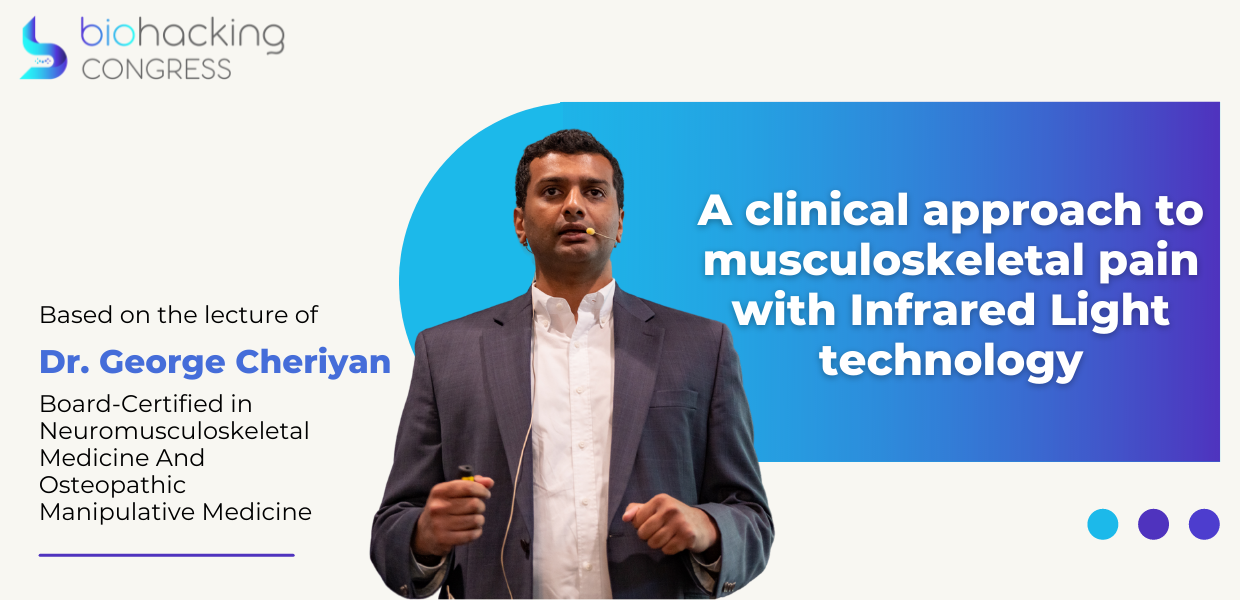A clinical approach to musculoskeletal pain with infrared light technology
Objectives of Clinical Approach to Musculoskeletal Pain Using Infrared Technology:
- Background of Infrared technology
- Clinical Considerations of Musculoskeletal causes of pain and use of infrared light technology
- Clinical Approach using infrared light technology for pain
“Infrared - it is a form of electromagnetic radiation. The infrared radiation (IR) band covers the wavelength range of 750 nm–100 μm, frequency range of 400 THz–3 THz, and photon energy range of 12.4 meV– 1.7 eV. It lies between the long-wavelength red edge of the visible and the short edge of the terahertz (starting at 3 THz) spectral bands Its wavelengths are greater than visible light and therefore cannot be seen.
Red light therapy is similar, but it can be seen. It is also called low-level laser therapy (LLLT), low-power laser therapy (LPLT), and photobiomodulation (PBM). The red light wavelength is approximately 650 nm.
The classification of infrared light has three subdivisions for infrared radiation: near-infrared, mid-infrared, and far-infrared, it's known as ira or infrared A, infrared B, and infrared C respectively the wavelength.

Increasing the wavelength of light increases the penetration depth through the skin so it all depends on what your goal of using this technology would be.”
How does it work? Mechanism of action.
- Absorption of red light or near-infrared light by mitochondrial chromospheres (cytochrome c oxidase). This leads to an increase in Nitric Oxide and ATP.
- Other signaling pathways are triggered by NO and ATP which can lead to anti-inflammatory effects and pain relief.
“There are three different types of muscles in the body: smooth muscle, skeletal muscle, and cardiac muscle. A vasculature is a muscle contract that expands so that's one of the effects that it will have is what we call vasodilation. Also, nitric oxide release relaxes the skeletal muscle. When you have vasodilation you have more blood flow so what I find with a good treatment with one of ZeroGravity's devices is that if you want to get nice warmth emitting from whatever your target muscle was. That's important to note so the muscle and the skin will get warm from the device itself but also it will be a lasting warmth because of the relaxation and blood flow that's going to that area.
When you have more real relaxation of muscle and increased blood flow you will have anti-inflammatory effects. It's kind of it's pretty simple you may have an inflammatory reaction but that's completely normal and that might be due because if you've been if a muscle has been contracted for an extended period, we're talking about six months, or like a chronic issue or more what happens is as you get more blood flow the body creates an inflammatory cascade to help it heal itself. So one of the things I let my patients know after I treat them is that they might feel sore like a workout sore.”
Moving on to what pain syndromes do infrared light treat. There is so much evidence out there that it's hard to ignore this.
Can infrared light therapy help relieve musculoskeletal pain?
- Chronic Low back pain: Study (2006, Rothbart) - Randomized controlled study with n = 40 demonstrated significant relief of chronic low back pain with an infrared technology device FDA approved.
- Neck pain: Numerous studies show low-level light therapy (LLLT) effective reduction of acute neck and chronic neck pain
- Achilles Tendinopathy
- Post-surgical pain

I want to discuss how you approach somebody with this technology. What do you need to do?
- Do a thorough history intake
- Do a complete musculoskeletal examination of the target area to be treated.
- An expert-level knowledge of anatomy, biomechanics, and physiology is needed for individualized care.
- Localized to the area to be treated and understand the systemic effect relaxing the myofascial structures will have physiologically and mechanically.
- Rule out red-flags
- Develop a plan of action for treatment that may or may not consider photobiomodulation treatment.
How to approach based on diagnostic criteria?
Somatic Dysfunction: Impaired or altered function of related components of the body framework system: skeletal, arthrodial, and myofascial structures, and their related vascular, lymphatic, and neural elements.
Diagnostic Criteria: (TART) Tenderness, Asymmetry, Restriction of Motion and Tenderness
The gradient of severity: Mild, Moderate, Severe
Other symptoms to consider: Hypertonic Muscle, Erythema, Cause of pain, Mechanism of Injury, displaced bones.
Rational treatment based on Osteopathic Philosophy:
- Structure and function are reciprocally interrelated.
- The body is one dynamic unit of function
- The body has an innate ability to heal itself

“Even though the body's one dynamic unit of function, you can approach it in a few ways. And there's no such thing as a wrong approach, and you have to do what's best for your clients, for your patients, etc. Using infrared light technology you could have a generalized approach where you're targeting light in a non-focused manner to be dispersed in more than one area or throughout the whole body. While you could also approach it in a focal way where you could be specific to a certain muscle to a group of muscles to the fascia to a nerve etc so it depends on what your goal is.”
A generalized approach using infrared light therapy vs Focal approach to infrared light therapy
Generalized Approach - Targets the infrared light to be dispersed at a more general area or the whole body
Focal Approach - Targets the infrared light to be more focused on a specific muscle or region

In conclusion, infrared light technology is a safe and simple approach to relieving pain, remember you have goals when you're treating someone, understand the difference between the generalized and local approaches to treating with infrared and remember the body's dynamic and its biomechanical physiological effects it may have in the grand scheme.
- Photobiomodulation is a safe and simple approach to help relieve pain
- Remember to have key goals for treatment and know what you are trying to treat.
- Understand the difference between a generalized approach with the use of infrared light therapy and a focused approach to infrared light therapy.
- The body is dynamic so consider all the biomechanical and physiological effects you may have.
BiohackingCongress Team is very grateful to Dr. George Cheriyan, Board-Certified in Neuromusculoskeletal Medicine And Osteopathic Manipulative Medicine, and speaker by ZeroGravity, for joining the BiohackingCongress and giving an incredible lecture.
Watch George Cheriyan’s 40-minute lecture and 50+ lectures, panel discussions, and performances from renowned biohackers on biohacking your body with a BiohackingCongress year-long subscription. Get your access to a healthy future now!
Subscribe to watch more Videos with Top Biohackers. Stay tuned into the latest biohacking products for biohacking your health and biohacking for longevity.
Based on the lecture by George Cheriyan
Special Access to
Exclusive TopBiohacks
and more



